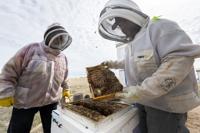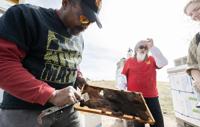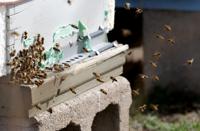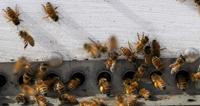After a tough winter, Colorado beekeepers are busy keeping hives alive
For Lazarus Fields, there’s always something new to learn about bees.
“Every hive has their own little temperament,” he said, standing in a buzzing backyard on the northeast border of Colorado Springs.
The longtime beekeeper, who doubles as a school teacher in Colorado Springs School District 11, can be found this time of year traveling around the Pikes Peak region on an itinerant mission: managing hives during swarm season.

Lazarus Fields, right, and Frankie Bailey inspect a hive on Angela Kataza’s property east of Colorado Springs on Friday, March 28, 2025. Fields is the swarm coordinator for the Pikes Peak Beekeepers Association. (The Gazette, Christian Murdock)
For a few weeks in spring, honeybee colonies might split to create hives as part of a natural reproductive cycle. If left alone, the new hive could end up in inconvenient places. Enter Fields, who is the swarm coordinator for the Pikes Peak Beekeepers Association and an apiary consultant.
“If you don’t catch them, or you don’t manage your bees, they end up in structures and hollow trees, doghouses, water mains. I’ve seen some crazy places,” he said.
Fields’ work is the opposite of pest control: that feral hive in the back shed or dead standing tree is a valuable colony to extract and preserve. A propagating hive is often a healthy one, and for the last couple of decades, healthy bees have been difficult to maintain in the United States.

Lazarus Fields checks the combs of a hive on Angela Kataza’s property east of Colorado Springs on Friday, March 28, 2025, while Frankie Bailey looks on. (The Gazette, Christian Murdock)
Since the turn of the millennium, bee colonies have been prone to disaster at alarmingly high rates in North America. This winter, commercial beekeepers were hit particularly hard by die-offs upwards of 60%.
The cause has been attributed to many things, including diseases carried by mites, human development, use of pesticides and other factors that make life hard for bees. Colorado, with its harsh winters and high-elevation ecology, is not the ideal habitat. Honeybees were introduced in the U.S. in the 1600s and are not native to this continent.
Most of the hives outside Angela Kataza’s home were doing well during Fields’ visit in late March. One was dead, with some evidence of wax moth infestation.
“It’s a hot mess,” he said.
Donning a protective mesh suit, Fields pulled out and inspected racks of honeycomb filling with shimmering pollen or “bee bread” from a humming colony. He poured sugar water into feeders in the square, plywood container, hoping for a controlled propagation of the hive with plenty of fuel for new bees.
“This hive is doing excellent,” said Frankie Bailey, a fellow beekeeper and helper on the hive check with Fields that day.
Fields, though he agreed, was more cautiously optimistic with snow still in the forecast.
“Don’t count your bees before they winter,” he said.
Sustainable beekeeping Fields puts in more mileage than the average hobbyist beekeeper. It’s all in an effort to beat the odds year-to-year in an agricultural practice suffering from stresses on multiple fronts.

Lazarus Fields points out a queen cell, lower left, that stands out among the other cells in a hive on Friday, March 28, 2025. Fields is the swarm coordinator for the Pikes Peak Beekeepers Association. (The Gazette, Christian Murdock)
“A lot of it has to do with how we treat bees,” he said.
The majority of honeybee hives in the United States belong to commercial apiaries — operations that can maintain thousands of hives. Since imported honey consistently keeps the market price too low to be very profitable, the most financially viable use for honeybees is pollination. Each spring, millions of bees are shipped to California from across the country to pollinate almond trees in the Central Valley. As almond demand goes up, so does demand for the essential labor of bees.
“Why honeybees are so important to humans is that we can pick them up and move them to where we need them,” said former bee research scientist and Saint Louis beekeeper Jim Masucci.
The seasonal congregation of bees to California monoculture crops might be contributing to the devastating effects of disease and pesticides on the overall population, Masucci said. What would otherwise be pockets of outbreak can spread nationwide in the span of a season.
“I consider almond pollination like sending your kid to kindergarten or day care,” Masucci said. “It’s so easy to swap germs.”
Research is still ongoing, but Masucci said he suspected the mass die-off last year might have been a “perfect storm” of new diseases, widespread drought conditions and continued pressure from the agricultural industry to ship struggling bees to new environments. Colorado has its share of commercial apiaries, many of which also sell bees to hobbyists.
The hope of Fields’ strategy is to cultivate local colonies that can survive multiple seasons, withstand diseases and thrive through expanding human development — all without heavy use of chemicals.
“It’s all about, for me, sustainability,” he said.

Worker bees return to their hive with pollen, yellow powder on their legs, on Friday, March 28, 2025. (The Gazette, Christian Murdock)
He has had success staving off major population decline, losing about 15% to 20% of his bees each year. He said the right care for bees is still a guessing game.
“I lose bees, too,” he said, shrugging. “It’s agriculture.”
Don’t kill the dandelions
Colorado beekeepers are used to picking themselves back up again after disappointment.
“I sat in my yard and cried when it happened,” said Pueblo beekeeper Dru Spinuzzi about the loss of the majority of her bees two years ago. As co-president of the area beekeeper’s association, she said people do give up sometimes. It’s hard to find a dead hive.
Despite the almost guaranteed heartbreak, she said beekeeping is a growing hobby in southeast Colorado. The pandemic was many beekeepers’ starting point.
“People were trying to go natural,” she said.
The Pueblo County Beekeepers Association has grown significantly over the past eight years. The group hosted a conference this spring with speakers from all over the U.S. — one of whom was Masucci. Vendors set up outside selling honey wares and beekeeping accessories.
For some, keeping bees goes hand in hand with agriculture and gardening. Kataza said she set up her first colony with help from Fields when she noticed her zucchini crop dwindling.
“My garden was not being pollinated,” she said.
At the edge of residential developments and urban sprawl, Kataza said her bees are sensitive to human impacts on the environment. She implores people not to use Roundup, a common weed killer, on their lawns, especially to kill bee-friendly early spring plants like dandelions.
“Don’t do that,” she said. “The sprays are horrible.”

Worker bees return to their hive with pollen, yellow powder on their legs, on Friday, March 28, 2025. (The Gazette, Christian Murdock)
While honeybees are not native, they do share an environment with Colorado’s indigenous pollinators — wasps, moths and many other bee species.
Ashley Burley, vending for her family apiary in Cañon City at the Pueblo County Beekeepers Association conference, said that landscaping with a variety of native plants can spread benefits around the insect world.
“You want to make sure you have a good diversity of native species,” she said.
If a honeybee swarm ends up in an unwanted place in the Pikes Peak area, Fields says give him a call.
“I am the keeper of bees, or they could be the keeper of me perhaps,” he said.






댓글
댓글 쓰기